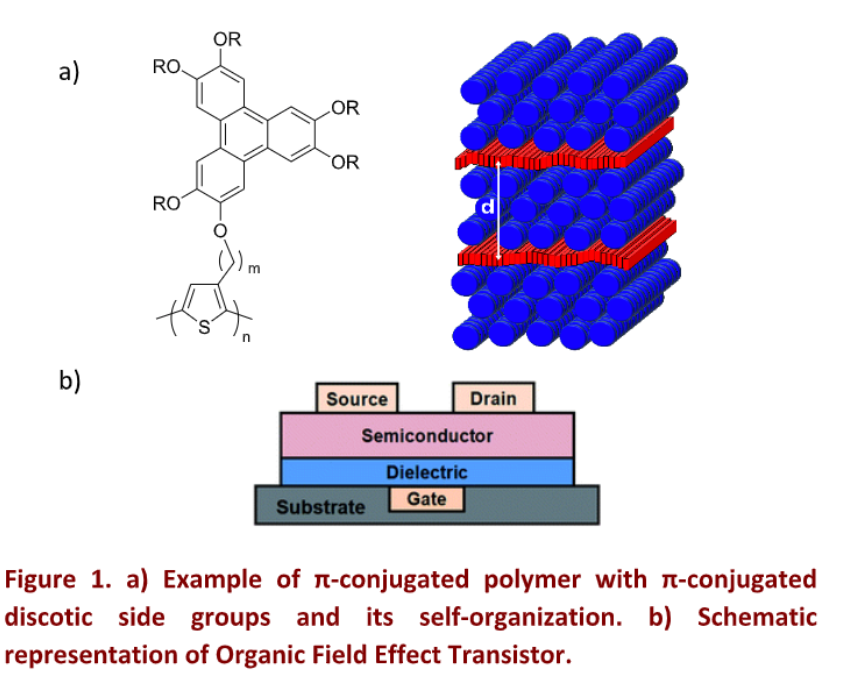Donor-acceptor semiconducting macromolecular architectures for optoelectronic applications
Fabrice Mathevet, Yiming Xiao, Danli Zeng, Bertrand Donnio, Benoît Heinrich, Chihaya Adachi, David Kreher, Jean- Charles Ribierre, Jamal Moussa, Lydia Sosa Vargas,

The self-organization of π-conjugated organic materials forming highly ordered supramolecular architectures has been extensively investigated in the last two decades in view of developing and fabricating light-weight, flexible, low-cost and high-performance organic optoelectronic devices. Indeed, the control of both the mesoscopic and nanoscale organization within thin semiconducting films, and the establishment of reliable structure-properties relationships are the key issue for the improvement of charge transport properties and achievement of high charge carrier mobilities. These well-ordered materials are currently either self- organized semiconducting polymers[1] or liquid crystal derivatives[2- 3]. In this context, we endeavored to investigate the self-organization of semiconducting liquid crystalline materials incorporating different kind of π-conjugated systems in unique molecular or macromolecular architectures. Here we describe the design and synthesis of (i) dyads and triads combining discotic or calamitic π-conjugated mesogens, and (ii) side-chain liquid crystal semiconducting polymers where the backbone is a π-conjugated polymer and the side groups are pi- conjugated discotic mesogens (Fig. 1a). This approach allows to prepare intertwined co-assemblies in self-organized materials, leading to a new class of nanostructured supramolecular organic semiconductors [4-6]. In this work, we will give the details on the synthesis, structural characterization and morphology studied by Polarized-light Optical Microscopy (POM), Differential Scanning Calorimetry (DSC), Temperature-dependent small-angle X-ray diffraction, Grazing-incidence X-ray scattering (GIXS) and Atomic Force Microscopy (AFM). Moreover, their charge transport properties studied in Organic Field Effect Transistor configuration will also be depicted (Fig. 1b), showing that this kind of materials can provide a simple and versatile route to elaborate semiconducting materials incorporating two intercalated separate pathways for the transport of charge carriers, leading to a new class of supramolecular ambipolar materials.

References
- H. N. Tsao, K. Müllen Chem. Soc. Rev. 2010, 39, 2372.
- T. Wöhrle, I. Wurzbach, J. Kirres, A. Kostidou, N. Kapernaum, J. Litterscheidt, J. C. Haenle, P. Staffeld, A. Baro, F. Giesselmann, S. Laschat Chem. Rev. 2016, 116, 1139.
- Y. Shimizu, K. Oikawa, K.-I. Nakayama, D. Guillon J. Mater. Chem. 2007, 17, 4223.
- D. Zeng, I. Tahar-Djebbar, Y. Xiao, N. Kayunkid, M. Brinkmann, D. Guillon, B. Heinrich, B. Donnio, E. Lacaze, D. Kreher, F. Mathevet, A.-J. Attias Macromolecules 2014, 47, 1715.
- Y. Xiao, D. Zeng, L. M. Mazur, A. Castiglione, E. Lacaze, B. Heinrich, B. Donnio, D. Kreher, A.-J. Attias, J.-C. Ribierre, F. Mathevet. Polymer J. 2017, 49, 31.
- X. Zhu, C. Hessin, A. Salamé, L. Sosa Vargas, D. Kreher, C. Adachi, A. Proust, P. Mialane, J. Marrot, A. Bouchet, M. Sliwa, S. Méry, B.Heinrich, F. Mathevet, G. Izzet Angew. Chem. 2021, 60, 8419.